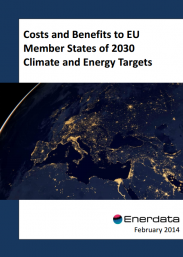
Costs and Benefits to EU Member States of 2030 Climate and Energy Targets

Executive Summary
Delivering both economic growth and GHG emissions reductions is essential to avoiding dangerous climate change, with its associated economic, social and environmental costs. Keeping the global temperature rise below 2°C represents a major challenge, particularly while ensuring decarbonisation is cost-effective and maintaining security of supply and competiveness. A number of policies have been implemented throughout the EU to reach its 2020 targets; the next challenge is to look ahead to 2030.
To continue the process of transforming to a low carbon economy and set the next waypoint towards the EU’s 2050 objective of reducing GHG emissions by 80-95%, the European Commission has released its proposal for an EU 2030 framework for climate and energy policies. Pursuant to this, the UK’s Department of Energy and Climate Change commissioned a set of detailed quantified scenarios for GHG emissions and the energy sector, in order to look at the costs and benefits to individual Member States and the EU as a whole from different potential EU policies and objectives for 2030.
Significant potential exists within the EU to reduce GHG emissions at reasonable costs, both in the short and long term. The 20% reduction of emissions by 2020 will likely be overachieved despite the current low ETS price; indeed, even with the existing surplus of EUAs, this will probably be the case without further policy intervention. The Commission’s Low Carbon Roadmap suggests that a tighter cap and target would put the EU on a more cost effective pathway to 2050.
- Issues:
- Infrastructure, Energy, Climate Change, Natural Resources
- Region:
- Europe
- Year Published:
- 2014
- Institution:
- Enerdata

